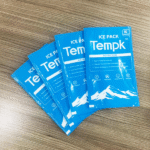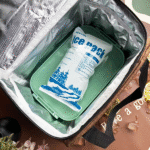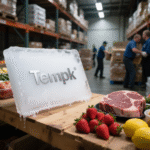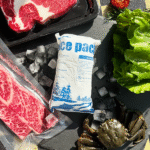Como enviar eficazmente através do país usando placas de gelo seco para produtos sensíveis à temperatura?
O transporte de produtos perecíveis ou sensíveis à temperatura através de longas distâncias requer um método confiável e eficiente para manter as temperaturas exigidas. As placas de gelo seco são uma solução poderosa na logística da cadeia de frio, permitindo que as empresas otimizem seus processos de remessa e, ao mesmo tempo, minimizem a deterioração. Este artigo explorará as melhores práticas, desafios, e tendências no envio de placas de gelo seco em todo o país.

-
A importância de usando folhas de gelo seco em transporte cross-country
-
Melhores práticas para usar folhas de gelo seco
-
Como as empresas podem otimizar seus processos de envio com gelo seco
-
As últimas tendências e inovações no transporte de gelo seco
Por que você deve usar folhas de gelo seco para envio?
As placas de gelo seco são uma ferramenta crítica para manter a estabilidade da temperatura durante remessas entre países. Eles ajudam a manter a temperatura baixa sem as complicações do gelo tradicional. Ao enviar mercadorias sensíveis, como produtos farmacêuticos, comida, ou amostras biológicas, manter temperaturas consistentes é crucial. O gelo seco garante que os produtos sejam entregues em ótimas condições, reduzindo deterioração e perda.
Estudos mostram que o uso de gelo seco pode reduzir significativamente as taxas de deterioração em até 75%. A razão é que o gelo seco é dióxido de carbono sólido, que sublima em gás a -78,5°C, mantendo uma temperatura fria constante durante todo o processo de envio. Isto o torna ideal para indústrias onde as flutuações de temperatura podem impactar drasticamente a qualidade do produto..
Como o transporte de gelo seco beneficia sua empresa?
-
Eficiência de custos: O gelo seco é uma opção econômica para transporte de longa distância, reduzindo a necessidade de unidades de refrigeração caras.
-
Não-derretido: Ao contrário do gelo tradicional, gelo seco sublima em gás, não deixando umidade que possa danificar os produtos.
-
Vida útil estendida: O gelo seco oferece uma duração de resfriamento mais longa em comparação com os pacotes de gel, garantindo que os produtos permaneçam em ótimas condições durante o trânsito.
-
Sem bagunça: A falta de água líquida torna o gelo seco a solução ideal para o transporte de itens delicados como eletrônicos e produtos farmacêuticos.
Quais são as melhores práticas para usar gelo seco em remessas?
Use a quantidade certa de gelo seco
O uso de gelo seco normalmente varia de 5 para 10 libras por 24 horas de tempo de envio, dependendo do tamanho da remessa e dos requisitos de temperatura. Itens mais perecíveis ou tempos de trânsito mais longos exigirão mais gelo seco.
Rotulagem e documentação adequadas
As remessas de gelo seco devem ser devidamente etiquetadas. Use o “Dióxido de Carbono Sólido” rótulo para indicar que a embalagem contém gelo seco. Isso garante o manuseio adequado e a conformidade com os regulamentos de transporte.
Garanta o isolamento adequado
A embalagem é crucial para manter a eficiência do gelo seco. Use caixas ou recipientes isolados para reduzir a quantidade de gelo seco necessária. No entanto, esses recipientes não devem ser herméticos, permitindo que o gás escape com segurança.
Incluir dispositivos de monitoramento de temperatura
A inclusão de dispositivos de monitoramento de temperatura nas remessas garante que a temperatura permaneça dentro da faixa exigida. Esses dispositivos ajudam a rastrear as condições em tempo real, dando às empresas mais controle sobre o processo de envio.
Descarte e medidas de segurança
Eduque os destinatários sobre como descartar gelo seco com segurança. À medida que sublima em gás, deve ser ventilado em uma área bem ventilada para evitar acúmulo de pressão.
Como as empresas podem otimizar seus processos de remessa com gelo seco?
A otimização dos processos de transporte de gelo seco pode reduzir custos e aumentar a eficiência. Aqui está como:
Revise os dados históricos de remessa
A análise de remessas anteriores pode ajudar as empresas a identificar padrões, entender os métodos de embalagem ideais, e determinar as quantidades mais econômicas de gelo seco necessárias.
Treine a equipe sobre o manuseio adequado
O treinamento adequado garante que os funcionários manuseiem gelo seco e produtos sensíveis à temperatura de maneira eficaz. Este treinamento pode reduzir erros, melhorar a eficiência, e reduzir o desperdício.
Aproveite a tecnologia para monitoramento e eficiência
Investir em tecnologia de monitoramento de temperatura que monitora as condições em tempo real durante todo o processo de envio ajuda a garantir que os produtos cheguem com segurança. Algumas empresas também usam soluções baseadas em IA para otimizar o uso de gelo seco com base nas condições de envio.
Trabalhe com fornecedores de logística experientes
A parceria com empresas de logística especializadas em logística de cadeia de frio e remessas de gelo seco pode agilizar ainda mais o processo e garantir a conformidade com os regulamentos de transporte.
Conformidade regulatória e diretrizes de segurança para remessas de gelo seco
O gelo seco é classificado como um material perigoso (E 1845) sob os EUA. e direito internacional. A conformidade protege não apenas a remessa, mas também as transportadoras e os usuários finais.
NÓS. Regulamentos (49 CFR § 173.217)
-
Embalagem ventilada: Os recipientes devem permitir que o CO₂ escape para evitar o aumento de pressão e a ruptura.
-
Rotulagem: Os pacotes devem ser marcados “Dióxido de carbono, Sólido” ou “Gelo Seco,” Inclua o número da ONU 1845, e liste o peso líquido do gelo seco.
-
Limites de quantidade: Pacotes contendo 2.5 kg (5.5 Libra) ou menos de gelo seco usado como refrigerante estão isentos da maioria dos requisitos de materiais perigosos.
Ar, Chão, e Limites Marítimos
| Modo de transporte | Máximo de gelo seco por pacote | Requisitos de embalagem/rótulo | Por que isso importa |
|---|---|---|---|
| Voos de passageiros | 2.5 kg (5.5 Libra) | Recipiente ventilado; Etiqueta “Gelo Seco”; peso líquido e ONU 1845 marcação | Previne o acúmulo de CO₂ e o risco de asfixia nas cabines |
| Voos de carga | Até 200 kg (440 Libra) | Mesma rotulagem; documentação adequada | Remessas maiores exigem documentação e ventilação |
| Transporte terrestre | Até 200 kg | Embalagem ventilada, rótulos de perigo | CO₂ pode acumular-se em veículos fechados |
| Transporte Marítimo | Segue o Código Marítimo Internacional de Mercadorias Perigosas | Ventilação e rotulagem semelhantes às diretrizes de ar | Tempos de trânsito longos aumentam o risco de aumento de pressão |
Regras adicionais de envio
-
Use placa de fibra de alta qualidade, plástico, ou caixas de madeira. Não coloque gelo seco em sacos plásticos lacrados ou tambores de aço; a embalagem deve permitir que o CO₂ seja liberado.
-
Afixar uma classe 9 etiqueta de perigo e incluir os nomes e endereços do remetente e do destinatário. As etiquetas devem ter pelo menos 100 mm × 100 mm e impresso em tipo 6–12 mm dependendo do tamanho da embalagem.
Melhores práticas para embalagem e camadas de folhas de gelo seco
Para maximizar o desempenho dos sistemas de placas de gelo seco, siga estes princípios de embalagem:
-
Pré-resfrie seu contêiner: Resfrie a caixa isolada e o produto até a temperatura desejada antes de adicionar placas de gelo seco.
-
Camada estrategicamente: Coloque uma folha na parte inferior, então o produto, depois outra folha por cima. Para trânsito de vários dias ou rotas de alto risco, adicione painéis superiores extras ou folhas mais grossas.
-
Envolva as paredes totalmente: Corte ou dobre folhas para forrar todas as paredes para evitar a entrada de calor pelas bordas. Esboce as dimensões da sua caixa com antecedência para evitar lacunas.
-
Monitorar temperatura: Insira um registrador de dados para monitorar a temperatura interna durante o transporte e ajustar remessas futuras de acordo.
O futuro do transporte marítimo de gelo seco
Em 2025, o transporte marítimo de gelo seco continua a evoluir com tecnologias emergentes e iniciativas de sustentabilidade. Novos materiais de isolamento estão sendo desenvolvidos para melhorar a eficiência do transporte, enquanto as soluções logísticas baseadas em IA ajudam as empresas a otimizar o uso de gelo seco com base nas condições de envio. Além disso, à medida que a sustentabilidade se torna uma preocupação crescente, há esforços para minimizar o impacto ambiental através do uso de energia renovável na produção de gelo seco e do emprego de materiais ecológicos nas embalagens.
Insights de mercado: Sustentabilidade e Expectativas do Consumidor
As tendências de sustentabilidade estão a impulsionar a procura de soluções de cadeia de frio mais eficientes e ecológicas. Como os consumidores exigem cada vez mais frescos, orgânico, e produtos sensíveis à temperatura, as empresas estão adotando práticas mais ecológicas para se manterem competitivas. As marcas que se alinham com estes valores, otimizando os seus processos de envio com materiais e tecnologias sustentáveis, podem construir uma maior fidelidade do cliente..
Perguntas frequentes
Q1: Quanto tempo dura uma placa de gelo seco durante o transporte internacional?
As placas de gelo seco normalmente mantêm condições ultrafrias por 24 a 48 horas. Para viagens mais longas, aumentar o número ou a espessura das folhas e adicionar um buffer para atrasos.
Q2: Posso enviar gelo seco via USPS?
Sim, mas as embalagens contendo gelo seco não devem exceder 5 libras para transporte aéreo.
Q3: Qual é o gelo seco máximo permitido em uma aeronave de passageiros?
2.5 kg (5.5 Libra) por pacote. Os voos de carga podem transportar até 200 kg por pacote, mas as políticas da companhia aérea variam.
Conclusão e recomendações
Para enviar com sucesso mercadorias sensíveis à temperatura através de longas distâncias, usar folhas de gelo seco é uma solução eficaz e confiável. As principais estratégias incluem cálculo de quantidade adequado, isolamento, rotulagem, e aproveitando a tecnologia para monitoramento de temperatura. Aderindo às melhores práticas e permanecendo em conformidade com os regulamentos, as empresas podem aumentar a eficiência e reduzir o risco de deterioração.
PRÓXIMOS PASSOS:
-
Avalie suas necessidades de remessa: Revise os requisitos de temperatura dos seus produtos e considere se o gelo seco é a melhor solução.
-
Otimize seus processos: Treine sua equipe no manuseio adequado e explore ferramentas de monitoramento de temperatura.
-
Consulte especialistas em logística: Colabore com fornecedores de logística experientes para garantir a conformidade e maximizar a eficiência do transporte.
Sobre Tempk
E tempk, somos especializados em fornecer soluções inovadoras de cadeia de frio, garantindo que seus produtos sensíveis à temperatura sejam enviados de forma segura e eficiente. Nossos produtos são projetados para atender aos mais altos padrões da indústria, oferecendo confiabilidade e desempenho incomparáveis.
Chamado à ação:
Entre em contato com a Tempk hoje mesmo para obter soluções logísticas personalizadas de cadeia de frio para otimizar seus processos de envio. Deixe-nos ajudar a garantir que suas remessas cheguem com segurança, toda vez.























